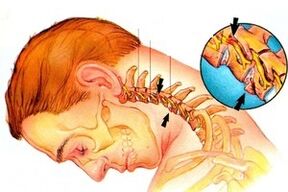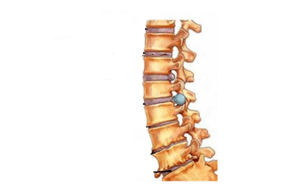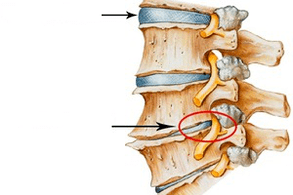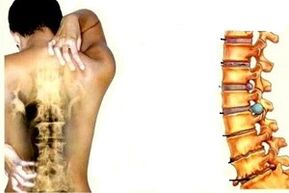
Muscle bone disease is one of the most common diseases of the Earth.Few people manage to completely avoid them, especially after 40 years, although experts admit that the problems of the spine, muscles and joints are "younger" and very young people are increasingly complaining about pain.
The fault of this is the lifestyle, which has learned to many: inactivity, longer -term stays in one position (most often behind devices and monitors), lack of physical activity.As a result, posture is disturbed, salts and other harmful substances accumulate in the body, the function of the muscle bone system is damaged, and as a result the internal organs may be deformed.
Most often, osteochondrosis comes from such diseases, which people are exposed to both older and young people, as well as osteochondrosis problems related to lumbosac and cervical spine.The second latest type of osteochondrosis, the cervix, is an unpleasant disease, and in addition - progressive, without treatment, a lifestyle that is significantly deteriorated to the disability.This means that it is necessary to detect the symptoms of the disease in time and to contact an orthopedic or spine treatment over time.
How does the cervical osteochondrosis develop
If a person leads a sitting lifestyle or is in the same situation for a long time based on his profession, the risk of satisfying osteochondrosis is very high.With the onset of the disease, changes in the interfaces between the vertebrae occur, deform and change their structure.
The intervertebral discs of the vertebrae are located between the vertebrae, which are responsible for maintaining, flexible and permanent spine.There are seven vertebrae in the neck that can be used to support and rotate the head, the neck and so on.The cervical vertebrae are very close to each other, so they are injured and shift even from minor physical efforts.The risk of the disease lies in the fact that the spine cords are influenced by nerve endings, which are affected by the blood vessels that provide the brain.The brain, on the other hand, does not receive vital substances, and this can lead to many other serious diseases that can cause disability and even the patient's death.
There are many reasons and development of the cervical osteochondrosis.Among the most common and frequent causes, the following can be distinguished:

- Impaired metabolism in the body, especially in the cervix region, hormonal imbalance;
- salt deposit;
- Low physical activity, sedentary lifestyle;
- Long stay in a pose (on the computer, the steering wheel of the car and so on);
- Inadequate nutrition;
- Overweight;
- neck injuries and bruises;
- Body hypothermia.
Osteochondrosis also occurs in the background of chronic diseases of the muscle bone system, such as skoliosis or rheumatism.
In addition, osteochondrosis often leads to the genetic predisposition of the body.
But whatever the reasons, osteochondrosis should be treated as soon as the first symptoms appear.
Cervical signs of osteochondrosis
Osteochondrosis in this spine is not always sudden and unexpected.Most often it develops slowly and the symptoms increase over time, increasing their numbers.The more the vertebrae are injured and the nerve roots are damaged, the more noticeable the signs are.
The first symptom to be paid is pain of different strength in the cervical spine, which is given to other parts of the body - the back of the head, forehead, ears, forearms, shoulders, chest and so on.In case of pain, consult your doctor to determine that it is indeed osteochondrosis, which is often similar to symptoms related to other diseases.
Other signs of osteochondrosis
- Cervical pain is enhanced by the load or turning of the head;
- The patient feels numbness, burns or tingling in the limbs;
- Headache and dizziness, demolition, the patient may complain of darkening and fly in his eyes, noise in his ears;
- The sharp turn of the head is probably fainting.
Osteochondrosis is also characterized by osteochondrosis of the cervix:
- violation of coordination;
- pain in the heart;
- The deterioration of vision and hearing.
Types of osteochondrosis
Depending on the nerve pinching and the nature of the disease, doctors distinguish more syndrome:
- spine syndrome;
- spinal arterial syndrome;
- Cardial syndrome.
Root syndrome is the first pair of cervical nerve endings.The pains are felt around the neck, with a plate, the back, shoulder, to be added to the forearm.
With spinal artery syndrome, the patient experiences pulsating pain in the back of the head or in the temples, or burning pain in the neck, the back of the head, which increases the head while sleeping, coughing, chest, shoulder.
With heart syndrome, symptoms first resemble angina pectoris, but the pain does not pass after taking nitroglycerin for several hours and may increase during movement and deep breathing.
Symptoms of damage to specific vertebrae
Treatment of osteochondrosis is prescribed based on nerve endings.There are a total of eight, each located above the cervical vertebrae.You can determine which vertebrae is affected by the symptoms appropriate to the specific nerve root.
Damage to nerve ending and its distinctive pain

- First and second stages: the sensitivity of the back of the head, the pain in the parietal and the oxy;
- Stage Three: Near numbness in the spicy area, impaired speech, tongue sensitivity;very rarely occurring;
- Fourth Stage: Pain and numbness in the collar and/or shoulder, respiratory system disorders, pain in the heart area;
- Stage Five: Pain in the shoulder, pain on the outside of the shoulder, the sensitivity of the limbs is impaired;
- Sixth and seventh sections: pain in the neck, shovel, forearm, back, back, hand, hands and fingers impaired sensitivity;the most common lesion;
- Stage Eight: Cervical pain, back, elbow, numbness of small fingers of all limbs, cyanosis of the feet and hands due to poor circulation, lack of sensitivity to the legs, radiating to the legs.
Diagnosis and treatment of osteochondrosis of the cervix

You must definitely consult a doctor to reliable the diagnosis of "cervical osteochondrosis".There are many symptoms of osteochondrosis similar to signs of other diseases, so not only the treatment of the treatment of osteochondrosis, but also the lack of another pathology.
In the case of suspicion of osteochondrosis and signs of nerve endings, the doctor prescribes radiography, data defect or magnetic resonance tomography, ultrasonic complementary dopplerography and duplex scanning.
Based on these tests, the nature of the pain syndrome, and other symptoms, you can determine which discs are damaged and may begin the necessary treatment that restores the affected vertebrae and nerve roots and does not allow complications of osteochondrosis.
Treatment is prescribed by the doctor, usually complex.First of all, the symptoms of pain, which are sometimes virtually unbearable with the cervix osteochondrosis, should be spread not only to the neck but also to other parts of the body.
To do this, use analgesics in the tablets, but in the case of too severe pain, non -stoic anti -inflammatory drugs, as well as warming and analgesics indicate.
Since drugs and ointments only relieve pain and other symptoms of cervical osteochondrosis, but do not be rid of the cause.After reducing painful feelings, the patient prescribes massages, physiotherapy and physiotherapy.The patient shows a diet, drugs that improve blood circulation and support the body's functions, tablets and injections, as well as chondroprotectors that promote the protection and restoration of intervertebral discs.
In some cases, baths, paraffin applications, reflexology, hirudotherapy are prescribed as additional treatment for the patient.Folk methods for treating cervical osteochondrosis often also rapidly contribute to the patient's return to the normal lifestyle, but they should only be used after traditional methods and consultation with a doctor, as conventional medicine can lead to contraindications and use the requirements of the body.
Complications and prevention of illness

Remember: the treatment of osteochondrosis of the cervix should be started as quickly as possible.The longer you attract a doctor's visit, the harder it will be to cure the disease and, in the meantime, can cause various complications.The cervical spine osteochondrosis is very dangerous as there are many blood vessels and nervous plexuses at this stage that nourish the brain.
Any violation can cause problems with cerebral circulation, neurological disorders, including migraine and hypertension, can affect the heart, respiratory system, hearing, vision.
If osteochondrosis is initiated, more serious consequences are possible in the form of ischemia, spinal stroke or radiculopathy - a disease in which the vertebrae processes develop, partly or completely deprived of sensitivity and mobility.But this is not the worst thing, as in the case of severe osteochondrosis, the spinal cord is compacted, which can cause the patient's death.
Therefore, it is very important to listen to the symptoms as soon as possible and contact a specialist who will help you to return to life.And to avoid a disease such as the cervix osteochondrosis, you need to move more, not avoid exercise, attention, carefully and balanced, and regularly visit an orthopedic or spine.

























